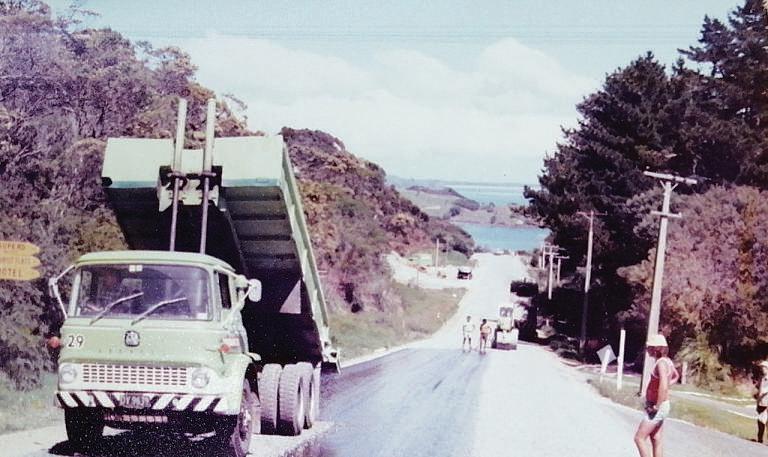
5 minute read
Roadworkers deal with danger every day


Advertisement

Roadworkers deal with
danger every day

Huge machinery surrounds them and hot bitumen can deliver serious burns. While trying to facilitate progress on the work site, they also have to keep traffic flowing as evenly as possible and deal with the impatience of motorists.
Fulton Hogan Far North area manager Russell Jecentho says his biggest fear is anyone being hurt, and safety training is treated seriously. He has noticed motorists have become less patient over the years.
“The people we have operating the stop-go signs are chosen carefully to have the right temperament as they will often cop a fair bit of abuse unfortunately. The public seems to be far less patient. They just want to go.’’
Jecentho is retiring this month from his 50-year career working for the same road building company.
He started working for Northland Road
Builders when he was 17 and over the years the company changed names to Reliable
Roads before becoming Fulton Hogan.
He knows all aspects of the job as he has worked in all of them over the years.
“When I started out I was lucky to have a boss who let us have a go on all the machinery.
I was like a kid in a sandpit,’’he said.
Jecentho said technology had made gear more driver-friendly, but also more technical.
“The basics of making a road are still the same but we use technology to help us. All the roads are surveyed with angles and cambers calculated for speed and corners.

“Grader drivers have information in the cab to know what percentage angles to set the grader blade. Shapes and angles are created for drainage. There’s quitealot to it,’’he said.
With a permanent staff of 43 and up to 65 in the busy road-building season, Jecentho’s day involves ensuring machinery is in the right place, the crews are organised and finances are sorted.
“Roads are expensive things. Projects are all priced out but there is always a chance we might hit unforeseen problems that require more resources.
“The big problem in Northland is water and the damage it can do to roads.’’
He said every road is different and coming up with solutions is part of the job.
“We are also trying to get each job done as quickly as possible and keep the traffic moving.
“Some jobs are super quick but others require more work if problems arise.’’
MACKENZIE WELDING 2013 LIMITED

See us for all your • Repairs & New Builds • Certification & Parts • Certified Welding • Abrasive Blasting • Macwel boats • Macwel bodies • Cranes for hire (1-25 tonne & 1 -12 tonne) • Logging Equipment • Welding & all Metal Supplies

AUTOMOTIVE & PERFORMANCE PARTS Proud to support our community.


CoopersBeach - Sealing mid 70s

Maintenance trucks are constantly surveying the region’s roads to identify and deal with any problems before they become major.
“We have maintenance crews clearing culverts, trimming trees and filling pot holes. They are moving around all the time keeping an eye on the state of the roads.’’
Jecentho said pot holes needed quick attention because cracks in the road could quickly develop into deep holes when trucks and cars keep hitting the fractured bitumen. Serious pot holes could be damaging to tires and dangerous for vehicle safety.
“The main window for roadworks is between September and April. We can’t do much over the winter months because bad weather affects our ability to work on the roads. Sometimes we have to do quick patches and come back in the summer to fix the roads properly.’’
Northland’s chaotic soils were the biggest challenge for road works, and more resources were needed to prepare the base than other parts of the country.

Storm damage is also a common seasonal problem for road maintenance.
Jecentho said the lime slurry, hated by motorists, was crucial for the formation of the base of the roads in Northland.
Lime is used to createachemical reaction with the clay to harden the soil and the metals being laid on top.
Sometimes cement is also used to create the solid surface needed for the bitumen roads.
Different types of bitumen mixes were selected for traffic volumes and road gradient.
Drainage is also important, and sometimes patches of road needed to be completely replaced in areas where water continually damages the road.
Roadworkers have to secure all the drains along each roadside to ensure damaging chemicals do not enter waterways while the work is underway.
“There’salot more to roadworks than most motorists realise.’’
He urged motorists to remove lime from their cars as quickly as possible and to use a bit of kerosene on a rag to remove any bitumen spots.
Keeping to the speed limits helps keep everyone safe as well as reducing the chance of chipped windscreens.
“Please have patience and give our people a wave. We are doing our best to let you go through but we do have to stop traffic to get the work done,’’ he said.
hewle t t s treet whangarei 09 470 0700



whang atane drive k aitaia 09 408 644 0





